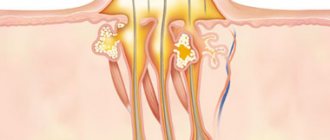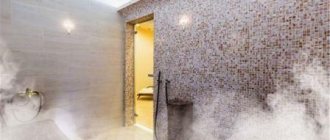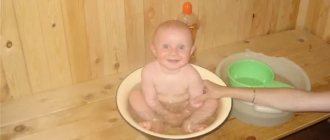Is it possible to go to the bathhouse and sauna and take a steam bath if you have sinusitis?
Many lovers of warming procedures are interested in the question of whether it is possible to go to the bathhouse with sinusitis.
Inflammatory processes in the paranasal sinuses cause significant discomfort to a person.
How to cure such a problem worries many people. For treatment, there are pharmacological agents and those offered by traditional medicine. A bath for sinusitis is one of the methods for treating inflammatory processes in the maxillary sinuses.
Like any illness, sinusitis leaves its unpleasant imprint on everyday life. And there are actions that it is better not to carry out, so as not to worsen the course of the disease and reduce the effectiveness of treatment. Knowing what is not recommended to do when you have sinusitis, you can avoid worsening and exacerbation.
Specifics of visiting the bathhouse
Whether to visit the steam room with maxillary sinusitis depends on the degree and stage of development of the disease. If neglect and complications are observed, water procedures such as a bath or swimming pool can aggravate the condition.
If the illness worsens, the body temperature rises to high levels or remains low-grade, you are not allowed to visit the sauna.
In the initial stages of the disease and in the absence of pronounced symptoms, a bath for sinusitis will bring certain benefits.
During bath procedures, a kind of treatment of the inflammatory process will be very useful, but you should not get carried away even if the symptoms are not clearly expressed. 10-15 minutes in the steam room is enough.
While in the sauna, you will greatly benefit from procedures using medicinal plants. You can put medicinal herbs on the stones or pour a pre-prepared decoction there.
Coltsfoot, plantain, yarrow, St. John's wort, and lavender have proven themselves well in the treatment of chronic sinusitis.
A drink is prepared from the above herbs, which is drunk while in the bathhouse. Dry herbs are poured with water, some are infused for a while, then they should be boiled for 10 minutes. Then the broth is infused for 2 hours. While in the bathhouse, you need to drink the prepared decoction.
What can you do and what can you not do?
If a person suffers from chronic sinusitis, it will be useful to steam your feet when visiting a bathhouse or sauna. It won't hurt to add a small amount of mustard, essential oils of pine needles, eucalyptus or mint to hot water.
A sharp change in temperature can negatively affect the condition and worsen the course of the disease, therefore, with sinusitis, regardless of what stage of treatment it is at, it is not allowed to go outside immediately after visiting the sauna.
It is important to remember that a bathhouse has significant differences from a sauna. This applies to the action of steam and air temperature, humidity. For those who like to steam in a bathhouse, the procedure for heating the lower extremities is more important. It is allowed to float your feet if sinusitis is in a chronic stage and the person does not feel a general malaise.
This procedure helps to warm up the entire body and is very popular in the treatment of colds. There is another variation of warming up in a bathhouse or sauna. A person should sit on a shelf, stretch out his legs and whip his feet with a bath broom. It will be more convenient if another person does it.
Such manipulations are allowed even with acute sinusitis. But you should not hover your nose during an exacerbation of the disease, as this can provoke a worsening of the condition.
An optional condition is to carry out foot manipulations in hot water; adding a small amount of dry mustard and essential oils to warm water will bring much more benefit.
Recommendations from experts
According to doctors, performing hygienic procedures or washing in a sauna for sinusitis will not harm or worsen the health of a person suffering from sinusitis.
Only here there are certain rules that should be followed:
- you cannot carry out water procedures or wash in a sauna or bathhouse in too hot or cold water;
- It is recommended to avoid getting water into the ear canals; to do this, before visiting the sauna, plug your ears with cotton wool;
- after a person has visited the steam room, it is not recommended to go outside until the end of the day;
- Be sure to dry wet hair with a hairdryer as quickly as possible.
The sauna is useful if used correctly. But the implementation of all procedures should be prescribed individually, depending on the stage of the disease and the severity of the disease.
How to cure an illness using bath procedures?
Sinusitis can be treated both with medications and with the help of recipes offered by traditional medicine. Sauna is one of the universal methods of treating many diseases.
Decoctions or infusions of medicinal herbs are prepared; they can be poured onto stones and the healing vapors can be inhaled.
The main herbs used by people suffering from sinusitis are: chamomile, St. John's wort, yarrow, coltsfoot, lavender.
Ointments are considered very effective to treat sinusitis. You can prepare them yourself. To do this you will need spruce resin, olive oil, onions and copper sulfate. An ointment is prepared from these ingredients, which is used to lubricate the nasal mucosa after visiting the steam room.
In the early stages of the disease, herbal applications are effective, which can be carried out in a bathhouse and at the same time steamed. Such applications have a disinfecting effect, can stop bleeding, relieve inflammation, and dilate blood vessels.
For such procedures, a collection of medicinal herbs is taken, poured with boiling water, infused, then the resulting pulp is applied to the sinuses and nose. The duration of the procedure is 10 minutes. Then bed rest is recommended. It is advisable to carry out such manipulations in courses of 10-15 times.
The sauna is an effective way to treat sinusitis when used correctly.
Source: https://pneumonija.com/nasopharynx/sinusitis/mozhno-li-pri-gajmorite-bez-vreda-hodit-v-banyu.html
Is it possible to go to the bathhouse if sinusitis is complicated by high body temperature?
You should avoid visiting the steam room and warming your feet in hot water if your body temperature has risen above 38 degrees. The fact is that even at a temperature of 37 degrees, the pulse increases slightly, blood pressure rises, and respiratory function worsens.
Exposure to hot steam and water will further raise your overall body temperature. Therefore, if the thermometer showed 38 degrees, then the answer to the question: is it possible to take a steam bath in a bathhouse?
It is necessary to direct maximum efforts towards cooling the body. Otherwise, there is a risk of severe pulmonary (respiratory) failure, seizures and even a heart attack.
Many people mistakenly think that steaming their legs with sinusitis complicated by elevated body temperature is much safer than visiting a bathhouse. However, such a procedure can do more harm than good.
Bathhouse and sinusitis: is it possible to take a steam bath with sinusitis?
Sinusitis is a disease caused by inflammation of the maxillary sinuses. The disease can be treated not only with medications, but also with the use of unconventional methods. When asked whether it is possible to go to the bathhouse if you have sinusitis, experts answer in the affirmative if this is the initial stage of the disease or the recovery stage.
The benefits of a bath for sinusitis
Exposure to high temperature and humidity has a positive effect on the human body. Blood vessels dilate, which helps reduce their tone, and muscles and tendons relax.
The work of the sweat glands is enhanced, and toxins and waste are removed through the skin pores.
Metabolism in the body accelerates, this allows the body to more effectively fight chronic diseases, inflammatory processes and congestion.
A bath for sinusitis is useful if the peak of the disease has already passed, the recovery stage has begun and all that remains is to achieve a complete recovery.
Exposure to high temperature effectively cleanses the mucous membrane of the maxillary sinuses from small foci of infection, helps relieve swelling, and makes breathing easier.
A hot steam room and warming up the feet have the same effect as inhalation procedures, but the effect occurs not only on the respiratory system and inflammation of the mucous membrane, but also on the entire body, which strengthens its defenses.
Features of the visit
After overcoming the peak of the disease, patients tend to undergo bath procedures. Such sessions, which make breathing easier and help improve the emotional background, should be short in time.
To resort to bath procedures that are effective in combating the manifestations of sinusitis, you should follow the visiting rules. If there is a desire to wash with sinusitis in a bathhouse, the patient should:
- Raise the atmospheric temperature slowly, carefully monitoring how you feel. Do not warm the air to such an extent that it becomes uncomfortable.
- Breathe hot air through your nose, taking deep breaths. Breathing should be calm and smooth.
- On your first visit, steam for only 15 minutes. After some time, it is allowed to increase the duration of bath procedures.
- Do not drink alcohol.
- Drink more liquid, which should not be cold. During a visit to the steam room, a large amount of sweat is released and it is recommended to restore the water balance in time.
- Avoid temperature changes. After the bath, it is important to warm yourself and lie in bed. To avoid thirst, you can drink tea or warm healing infusions.
- Try to prevent water from getting into the ear openings.
When is it contraindicated?
There are contraindications for treating sinusitis in a bath with high humidity and high temperatures. You should refrain from visiting the sauna:
- For severe sinusitis. In this case, resorting to bath procedures is unsafe. Under the influence of hot steam and air, the pus that accumulates in the sinuses begins to swell, its volume increases, and pressure begins on the walls. The pain intensifies, and the development of the disease only accelerates.
- In the presence of cardiovascular diseases. Under the influence of high temperature, all organs work under load, this can cause a hypertensive crisis. Especially when a person has previously experienced a heart attack or stroke.
- If you have undergone a course of treatment with strong medications. Substances remaining in the blood can cause a negative reaction, so it is recommended to refrain from visiting the sauna. The consequences can be unpredictable.
- Patients suffering from diabetes mellitus, chronic colitis, pyelonephritis, peptic ulcers and kidney diseases, infectious and chronic diseases.
- People with an increased tendency to bleed. Visiting the sauna is contraindicated due to the fact that as a result of increased blood circulation, pressure on the walls of blood vessels increases, which can cause heavy bleeding.
- If the patient has other inflammatory diseases in addition to sinusitis.
- If the patient has a fever. Sinusitis and a bath are incompatible in such a situation. Exposure to heated steam and air with thermometer readings above 38°C can cause acceleration of pathological processes, pulmonary failure, increased blood pressure, seizures or heart attack.
A hot sauna and sinusitis are compatible if the patient feels that he has enough physical strength and endurance.
Recipes for treatment in the bath
Doctors answer positively if the patient asks whether it is possible to go to the bathhouse after sinusitis. It is necessary to comply with the required conditions and adhere to the recommendations of a specialist when using folk remedies. The most popular recipes are:
- Steam decoction. This product is highly effective. The most suitable herbs would be plantain, lavender, dandelion, yarrow, chamomile, coltsfoot. The plant should be crushed and filled with boiled water. After infusion, add 3 liters of purified water.
- Herbal decoction for drinking. 20 g of St. John's wort and yarrow should be boiled in 1 liter of water and cooled. After straining, you should drink it during bath procedures, dividing it into 3-4 servings.
- Therapeutic garlic mask. Strong antimicrobial properties make garlic an indispensable remedy. You need to crush 3-4 cloves into a paste and apply the mask to the face in areas where there are inflamed sinuses - these are the sides of the nose and the area above the eyebrows. The duration of the procedure is 15-20 minutes.
- Solution for inhalation. Boil 1.5 liters of water and add a few drops of chestnut oil or 3 tbsp. leaves of this plant. Breathe slowly, splashing onto the heated surface as much as possible.
The procedure for treating sinusitis in the bath
The medicinal decoction prepared in advance should be sprinkled onto the heater, which should be well heated, and the fumes should be slowly inhaled through the nose, trying not to burn the mucous membrane.
A simple and effective way to influence the respiratory system is to inhale hot aromatic fumes that appear if you place freshly cut or dried medicinal plants on a hot surface, as well as drip various aromatic oils (lavender and fir).
It is recommended to rinse the nasal cavity using special solutions with salt water or healing herbal decoctions. This is a good moment for such a useful procedure, because high temperature and hot steam act most effectively, as a result, accumulations of pus begin to drain away.
You can do a light massage with a broom, improving blood flow to different parts of the body. After completing the procedures, it is recommended to sit and drink a cup of herbal tea.
Rules of behavior in the steam room with sinusitis
You can answer positively the question of whether it is possible to go to the bathhouse with sinusitis if the patient is familiar with the rules of behavior in the steam room with such a disease. It is important to pay special attention to your well-being. If your condition worsens, you should immediately stop the procedures and leave the bathhouse, and then lie down and relax, after drinking tea.
Find out the disease by its symptoms
Source: https://nosoved.ru/zabolevanija-nosa/gajmorit/poseshhenie-bani-pri-gajmorite.html
Is it possible to go to the bathhouse with sinusitis? Myths and arguments of ENT specialists
Sinusitis is a disease caused by an inflammatory process. In fact, sinusitis is a consequence of a classic cold, runny nose, flu or other foci of inflammation in the body.
Pus accumulates in the maxillary sinuses, which is the result of the struggle of leukocytes with harmful microorganisms.
Against the background of the disease, the mucous membrane of the nasopharynx becomes inflamed, the airways swell, which leads to nasal congestion, inability to breathe and a significant deterioration in health. Mucus can accumulate almost imperceptibly, after which serious purulent processes appear.
Sinusitis is almost always accompanied by the following symptoms:
- temperature increase to +38.5 °C;
- pain in the bridge of the nose, above the eyebrows, which radiates to the head and temples. The pain syndrome is especially evident when the head is tilted down and in different directions;
- decreased sense of smell;
- body aches;
- swelling of the face in the projection of the sinuses;
- decreased performance;
- increased fatigue.
Is it possible to take a steam bath if you have sinusitis? ENT specialists answer
A bathhouse or sauna always means high temperatures. Any otorhinolaryngologist will answer at the initial appointment of a patient diagnosed with sinusitis: warming the nose with sinusitis is not recommended! Firstly, thermal procedures can cause swelling, even death due to suffocation.
Secondly, sinusitis is a consequence of an infectious lesion of the body, and heating any infection is contraindicated. Thirdly, do not forget that the steam room is a public place that is visited by a large number of people every day.
A person with a weakened immune system can easily contract an infection, which will worsen an already problematic condition.
Myths about the treatment of sinusitis with a bath
1.High temperature will “kill” harmful microorganisms.
Unfortunately, it will not kill, but, on the contrary, in a warm environment, dangerous microorganisms will multiply more dynamically.
If the infection has already begun to spread throughout the body, it is necessary to wait until it is overcome on its own (or with the help of medications).
And elevated temperatures are always stressful! Imagine what will happen to you if you are stressed in a weakened state? That's right, there is no strength left to fight.
2.The humidity in the bath will help you recover.
Partly, yes, but not in the case of sinusitis... Humid air helps the body more easily tolerate respiratory diseases. The optimal air humidity in the room should be from 50 to 70% (under normal conditions this is achieved through the operation of a humidifier, frequent ventilation, regular wet cleaning, etc.).
However, even though the air in the bathhouse is humid, the temperature in the steam room is high. And, as you know, high temperatures can cause a deterioration in the condition and an increase in blood pressure. Hence the conclusion: let the air in the room where you are be humid, and you will always go to the bathhouse after recovery.
3.The bath will help cure sinusitis.
Unfortunately, the bath is not a panacea. If a patient has all the signs of sinusitis, and for help he goes not to the doctor, but to a bathhouse, this will significantly aggravate the situation.
It is important not to waste time with sinusitis, since the process of swelling is rapid.
The acute inflammatory process quickly becomes chronic, and sinusitis easily develops into an abscess and meningitis.
4.A bathhouse is the best recipe to avoid complications with sinusitis.
No, this is far from true! When heated, the swelling only intensifies, until the area in the area of the bridge of the nose and brow ridges turns blue. The swelling blocks the possibility of mucus leaving the sinuses, creating a situation where the pus wants to come out, but the sinuses are blocked... The pus “looks” for other outflow routes, that is, it goes into the ear canals, the brain, and this is extremely dangerous!
If a person has sinusitis in the chronic stage, but in remission, is it possible to visit the bathhouse?
It depends on the patient’s well-being and the time when the last exacerbation occurred. It is best to consult a doctor. Always remember: if you rarely visited the sauna in the past, then frequent visits after any respiratory disease are stressful. Stick to the preventive calendar of visiting the bathhouse, that is, about 2 times a month.
Will a bath help with sinusitis without high fever?
As otorhinolaryngologists note, sinusitis itself without fever is extremely rare. This may be classic sinusitis, rhinitis, or the so-called “hidden sinusitis”.
But all these diseases are inflammatory in nature, in which immunity is always reduced.
Temperature is a sign that the body is fighting an infection, and its absence is an alarming signal that there is no more strength left to fight, the body’s protective resources simply do not recognize the infection, and the process gradually turns from acute to chronic.
There may also be no temperature in case of allergic sinusitis, when the bacterial infection has not yet had time to join. Sinusitis cannot be cured by heating alone. Moreover, when serious purulent processes occur in the nasal sinuses, thick mucus is released from the nose. A comprehensive examination and competent treatment under the supervision of a specialist are required here.
When can you still go to the bathhouse after sinusitis?
Bath procedures will be useful during the recovery period after an illness, but under the following conditions:
- blood tests are normal;
- X-ray examination showed the absence of purulent contents in the nasal sinuses;
- temperature is ok;
- the person is in optimal health;
- the attending physician “gives the go-ahead” to visit the bathhouse.
With successful treatment of sinusitis, you can start visiting the bathhouse again 7-10 days after the official “discharge”, but it would be better to ask your doctor about this.
Bathhouse is the best prevention of sinusitis and other diseases of the ENT organs
But as a preventative program for ENT ailments, regular visits to the bathhouse are welcome! Active nasal rinsing, moist air, deep penetration of steam into the nasopharynx or inhalation, training the immune system - all this will strengthen the body and help build a reliable shield against infection.
The therapeutic effect of heating for diseases of the ENT organs is small, but the cost for complications is impressive! For acute and chronic sinusitis, follow the classic scheme of “diagnosis + treatment + doctor’s supervision”, and after complete recovery, the bath will only be beneficial!
Source: https://zen.yandex.ru/media/id/5c111820a525e100acb19c19/5c4f0ec1a91e8c00ac346ab7
In what cases should you not go to the bathhouse with sinusitis and why?
There are several key contraindications to visiting baths. You should absolutely not visit bath complexes during the stage of acute illness, as this can increase the activity of inflammatory processes.
You should not visit baths and saunas if sinusitis has developed into a more severe - purulent - form: clouds of hot steam will increase the production of pus, thereby complicating the disease even more. In addition, existing discharge will swell, increase in size and put pressure on the walls of the sinuses, causing discomfort and pain in the nose, bridge of the nose, and the frontal part of the head. During the period of acute sinusitis, high humidity should be avoided.
It is worth refraining from visiting the bathhouse even after completing a course of antibiotic treatment - the body will be so weakened that the steam room can cause another malfunction in its functioning. Complications after such a visit to the bathhouse will be much more complex than sinusitis.
In other cases, there is no reason to prohibit the bathhouse.
Bathhouse for sinusitis: how to steam properly
Sinusitis is an unpleasant and dangerous disease that causes difficulty breathing due to mucus congestion in the nasal sinuses. As a result of nasal congestion, constant hypoxia of brain cells occurs.
In medical practice, such a disease is in some cases treated as part of complex warming therapy.
Therefore, a bath for sinusitis can be a useful and effective treatment procedure if carried out correctly.
Is it possible to go to the bathhouse with sinusitis?
People suffering from inflammation of the maxillary sinuses are always interested in the question of whether a bath is useful for sinusitis . The answer to it depends on the stage of the disease and the causes that cause it. Dry or moist steam air has a therapeutic effect at different stages of this respiratory disease:
- at the initial stage, when the patient does not have elevated body temperature;
- during remission in chronic sinusitis, after the exacerbation is relieved;
- at the final stage of the disease, after the completion of the discharge of purulent mucus from the nose;
- at the stage of recovery after sinusitis.
The patient should always consult with his doctor before visiting the steam room.
Treatment of sinusitis is carried out in the course of complex therapy, selected for each patient individually, depending on the causes of the disease and the individual characteristics of the body.
A visit to the steam room can be an effective addition to complex therapy if it does not violate the therapy regimen chosen by the specialist.
Bath for sinusitis without fever
Is it possible to go to the bathhouse with sinusitis when a person does not have an exacerbation of this disease? Yes, you can. If a patient with inflammation of the maxillary sinuses does not have an elevated temperature, visiting the steam room will have a therapeutic effect on him.
Hot air performs the function of general inhalation, warming up not only the maxillary sinuses, but also the entire body, as a result of which the general blood flow increases and tissues are saturated with oxygen.
This relieves the effects of brain hypoxia and improves the general well-being of the patient.
The hot air of the steam room, which contains essential medicinal substances, kills microbes that may be present in the mucus that accumulates in the nasal passages. Hot air softens mucus and helps clear the maxillary sinuses. To increase the therapeutic effect, while staying in the steam room, you can rinse your nose with specially prepared herbal decoctions.
Dilatation of blood vessels helps to quickly remove mucus from the nasal passages, providing a therapeutic effect on the inflamed soft tissues of the nasal septum.
The skin opens pores through which toxins and wastes are eliminated, as well as waste products of pathogenic microflora, which can develop in places of stagnation in the maxillary sinuses.
The steam room helps relieve inflammatory processes at the initial stage, preventing them from worsening. As a result, it is possible to improve respiratory functions and reduce the effects of hypoxia on brain cells.
After staying in the steam room, the drainage of the nasal cavities improves due to the thinning of the mucus, swelling of the mucous membrane is relieved, and the damaged epithelium regenerates faster.
Why is a bath dangerous for sinusitis?
If you go to the bathhouse with sinusitis without consulting your doctor, you can worsen your health and cause an exacerbation of the disease. Often this disease is caused by pathogenic bacteria and viruses that actively develop in the mucus that accumulates in the nasal passages.
The development of pathogenic flora can lead to severe infectious forms of sinusitis, the treatment of which may require surgery. During bath procedures, a person may become hypothermic if visiting the steam room occurs in the cold season. As a result, the disease will begin to progress, and dangerous complications may arise.
You should not visit the steam room in the acute phase of the disease and if the patient has a fever. It is especially dangerous to go to the bathhouse with purulent sinusitis, since heating can cause an abscess and general blood poisoning.
Every patient who has been diagnosed with this should definitely consult with their doctor before deciding to visit the bathhouse. Often, as part of complex therapy, the doctor prescribes antibiotics against pathogenic microorganisms.
During the course of antimicrobial therapy, you should not visit the steam room. The specialist will tell you at what stage of treatment you can start using the bathhouse, based on the general condition of the patient and the stage of treatment.
Usually you can visit the steam room on the third day after completing the course of antibiotics.
Sinusitis can be effectively treated only as part of complex therapy selected by a specialist. If you do not comply with the treatment regimen, visiting the bathhouse during the acute phase of the disease or while taking antibiotics, you can nullify all the therapeutic effects of the medications and complicate the overall course of the disease, which can take a chronic form.
Is it possible to go to the bathhouse after sinusitis?
A bath after sinusitis can be an effective restorative course that will help eliminate residual congestion in the sinuses and improve overall well-being if bath procedures are carried out correctly.
Doctors often recommend including a visit to the steam room along with physiotherapy after completing drug treatment for sinusitis. In this case, a number of rules must be observed when visiting the steam room for people who have undergone treatment for inflammation of the maxillary sinuses:
- do not visit the bathhouse during the cold season, as there is a high risk of hypothermia and re-development of the disease;
- do not douse yourself with cold water;
- Do not take a steam bath if there are contraindications for such a procedure in the form of chronic diseases.
After treating sinusitis with medication, a patient can visit the bathhouse if he does not have:
- diabetes mellitus;
- hypertension;
- cardiovascular diseases;
- epilepsy;
- oncology;
- kidney diseases;
- problems with blood vessels.
After sinusitis, you should not steam at too high temperatures. The first stay in the steam room should not exceed 15 minutes. After the steam room, you should not immediately go out into the cold. While visiting the steam room, you need to drink as much as possible so that waste and toxins are quickly removed from the body along with sweat.
If you follow all the recommendations, visiting a bathhouse after such an illness will bring a therapeutic and preventive effect.
Does a bath cure sinusitis?
A bathhouse for chronic sinusitis at the onset of an acute form or after its relief can only bring a therapeutic effect if it is correctly integrated into the general treatment regimen of the patient, which can only be prescribed by his attending physician.
When self-medicating, there is a high risk of severe complications in the form of sepsis and pathological complications. The maxillary sinuses are located in close proximity to a number of areas of the brain located in the facial part of the skull.
When purulent foci of mucus accumulated in the nasal sinuses are heated, there is a high risk that the infection can spread to parts of the brain.
If the bathhouse is used under the supervision of an ENT specialist who prescribes treatment for the patient, it will bring a healing effect as part of the complex therapy of sinusitis. The bath procedure itself, like one medication, cannot cure such a pathology of the respiratory system, since its occurrence is influenced by several factors at once.
Source: https://taezhnyi.ru/blog/statya-1










